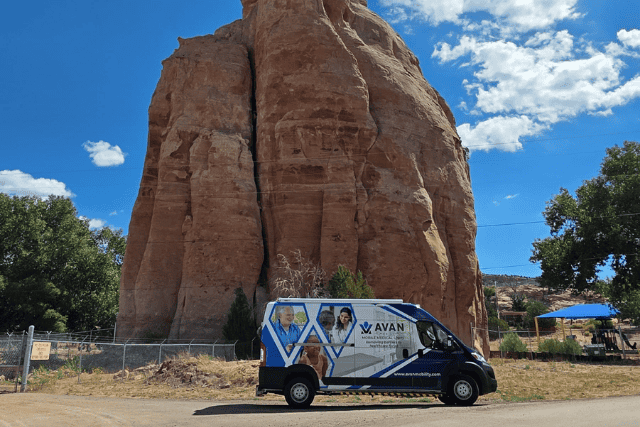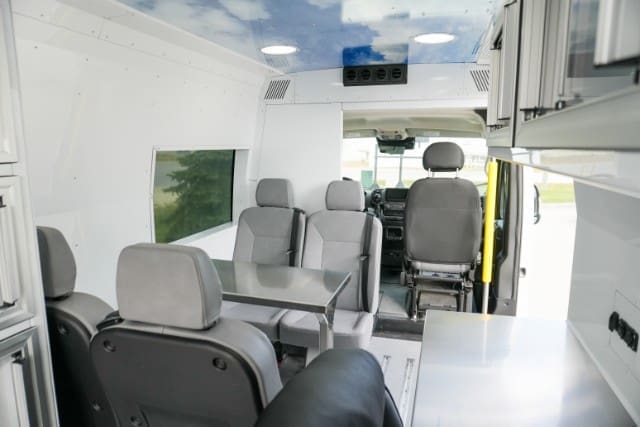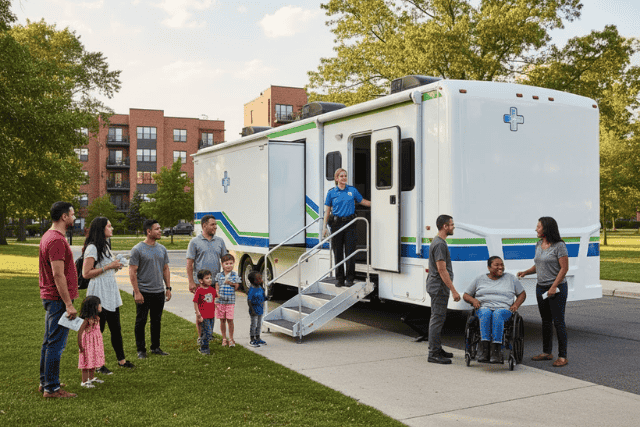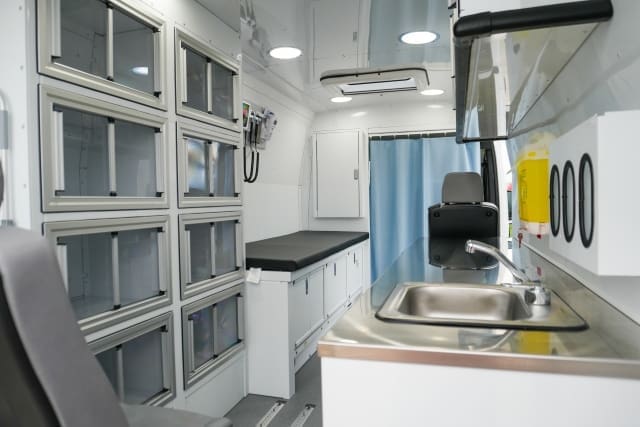Here in New Mexico, too many lives are still being lost to addiction. In 2022, the state had about 50 overdose deaths for every 100,000 people, one of the highest rates in the country. Behind every number is a story: A mom, a young person, or a neighbor who couldn’t get help in time.
Your organization likely sees these stories up close every day.
- Maybe it’s someone waiting weeks for a detox bed.
- Or a pregnant woman afraid to ask for help because she doesn’t want to lose her baby.
- Or a man recently released from jail who wants to start medication-assisted treatment but can’t find a clinic nearby.
New Mexico’s Early Access Behavioral Health Funding was made to change that. It’s helping organizations like yours expand crisis services, start medication-assisted treatment for justice-involved individuals, and build prenatal and perinatal substance use disorder programs that reach more people faster.
At AVAN Mobility, we’ve worked with hundreds of healthcare teams that face the same challenges. Over the last 10 years, we’ve built more than 150 mobile medical units for organizations like Janus of Santa Cruz and yours that bring care directly to the streets, neighborhoods, and rural towns where people need it most.
We’re Ford QVM and Stellantis QPro certified, and while we know we’re not the only company doing this work, we believe in listening first, building second, and always focusing on what matters most: Saving lives.
Here’s what you’ll learn in this guide:
- What behavioral health involves
- What New Mexico’s Early Access Behavioral Health Funding is and what it covers
- Who can apply, and how much funding is available
- Key conditions and deadlines to know
- How to apply for this funding
What branches of behavioral health does New Mexico’s Early Access Behavioral Health Funding cover?
When you hear the words “behavioral health,” you might think of counseling or mental health therapy. In New Mexico, it’s much bigger than that. The state’s Behavioral Health Reform and Investment Act includes many kinds of care that help people live healthier, safer, and more stable lives.
Behavioral health is about treating the whole person: Their mind, emotions, and the challenges they face day to day. That means this funding doesn’t only support fixed clinics. It can also help programs that focus on recovery, prevention, and outreach.
Here’s a look at the main branches covered by New Mexico’s Early Access Behavioral Health Funding and how they connect to real people across the state.
Mental and emotional health
This branch supports programs that help people manage stress, trauma, or mental illness.
It includes:
- Therapy and counseling: Talking with licensed professionals about what’s causing pain or anxiety.
- Psychiatry: Medical care and medication management for conditions like depression or bipolar disorder.
- Crisis response: Teams that answer calls or respond when someone is in a mental health emergency.
Imagine a student in Gallup who needs someone to talk to after losing a friend, or a team in Las Cruces helping someone in crisis. These services give people hope and someone to turn to when things feel impossible.
Substance use and addiction recovery
This part of behavioral health focuses on helping people overcome drug or alcohol use.
It includes:
- Medication-assisted treatment (MAT): Using approved medicines like Suboxone to support recovery.
- Addiction counseling and support groups: Helping people rebuild their lives with long-term care and encouragement.
- Programs for justice-involved individuals: Providing treatment for people leaving jail or prison so they can rejoin their communities safely.
Check out the video below to learn more about opioid settlement funding and how it can help you launch your program.
Social work and family support
Healing often takes more than medical care. Many people also need help with life’s basic needs.
This branch supports:
- Social workers: Helping clients find housing, food, and job training.
- Family counseling: Repairing relationships after addiction or mental illness.
- Community outreach: Connecting people to local programs and resources.
A family in Farmington might work with a counselor to heal after a difficult year, while a social worker in Roswell helps someone find safe housing after treatment.
Prenatal and perinatal substance use treatment
This branch supports pregnant and new mothers who are recovering from addiction.
Programs may include:
- Medical care for the parent and baby.
- Therapy and recovery programs.
- Mobile behavioral health units that travel to rural areas so mothers don’t have to go far for care.
These programs protect families and help babies start life healthy and safe.
Prevention and rehabilitation
This branch helps people avoid crises and build a stronger future.
It covers:
- Prevention programs: School education, early screenings, and public awareness events.
- Rehabilitation services: Job coaching, counseling, and group programs for people after treatment or incarceration.
When prevention and rehabilitation work together, fewer people end up in crisis—and more find long-term stability.
If your organization helps people with mental health, addiction recovery, family support, or prevention programs, you likely qualify for New Mexico’s Early Access Behavioral Health Funding. The goal is simple: to bring help closer to home for every New Mexican who needs it.
What is New Mexico’s Early Access Behavioral Health Funding, and what does it cover?
If you work in behavioral health in New Mexico, you probably know how hard it’s been to keep up with demand. Too many people are waiting for help, and some never get it. The New Mexico Health Care Authority (HCA) created New Mexico’s Early Access Behavioral Health Funding to change that.
This new funding program helps communities start improving care right now, instead of waiting years for statewide plans to roll out. It is part of the Behavioral Health Reform and Investment Act (SB 3), which was passed in 2025 to rebuild how behavioral health services are managed and delivered across the state.
The goal is simple: Help people faster, closer to home, and in ways that last.
Why does the funding exist?
For years, behavioral health services in New Mexico were spread thin. Many programs struggled to stay open, and rural areas often had little or no access at all. Some counties had no inpatient options for mental health or substance use treatment.
The Behavioral Health Reform and Investment Act changed that by creating a plan where all three branches of government work together. The state is now divided into 13 behavioral health regions, and each region will create a four-year plan with up to five priorities for care.
But waiting for those plans would take too long. So the HCA launched Early Access Regional Funding to bridge the gap. It gives regions and providers the chance to start building programs immediately using behavioral health funding for the state’s most urgent needs.
What does the funding focus on?
The HCA identified four critical access shortages across New Mexico.
These are the areas where help is needed most:
1. Residential treatment programs
2. Crisis response services
3. Medication-assisted treatment (MAT) for justice-involved individuals
4. Prenatal and perinatal substance use disorder treatment
Each behavioral health region can apply for up to $2 million in mental health funding in New Mexico, with a total of $26 million available statewide.
1. Residential treatment continuum of care
Imagine completing rehab only to have nowhere safe to go. This happens every day in New Mexico. People finish treatment, but they don’t have housing or follow-up support. Many relapse simply because they don’t have a stable place to stay.
The Residential Treatment Continuum of Care, part of New Mexico’s Early Access Behavioral Health Funding, helps fix that.
Regions can use funds to:
- Create or expand accredited residential treatment centers
- Build supportive or recovery housing for people finishing inpatient care
- Develop transitional housing that offers structure and safety
- Support treatment, foster care, or housing for youth in recovery
Here’s an example: A small nonprofit in Lea County already runs a recovery home for women leaving detox but can only take six residents. With this funding for mental health services, they could add another house and double their reach. More women would have a safe space to rebuild their lives.
This type of behavioral health funding focuses on long-term stability, not short-term fixes.
2. Crisis continuum of care
When someone is in crisis, every minute counts. In some rural counties, calling for help can mean waiting hours for transport to an emergency room miles away. Too often, police or EMTs become the first responders for mental health emergencies.
The Crisis Continuum of Care, part of the program, helps regions create faster, safer responses.
Funding can be used for:
- Crisis triage centers that stabilize people before things worsen
- Mobile crisis teams that meet people in their homes or communities
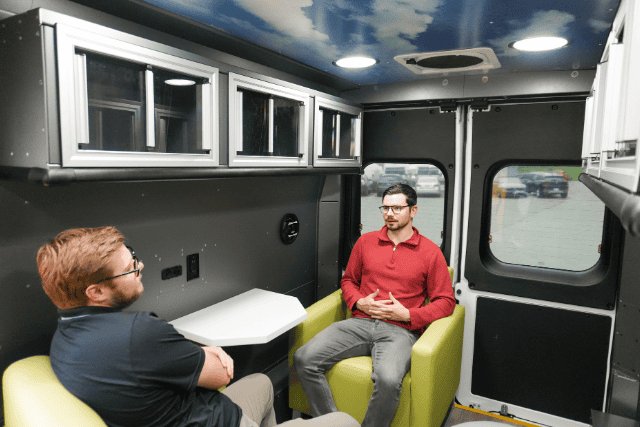
- Certified Community Behavioral Health Clinics (CCBHCs) that provide integrated care. Learn how to become one.
- Assertive Community Treatment (ACT) teams that bring services directly to clients
Picture a small town in Socorro County. When someone experiences a breakdown, the only option might be a hospital 90 minutes away. With substance abuse funding, the county could launch a mobile crisis unit staffed with trained counselors who drive directly to the person’s location. They can assess the situation, calm things down, and connect the person to ongoing care without involving law enforcement.
In many communities, mobile behavioral health units like these are becoming essential. They remove one of the biggest barriers to care: Transportation. These mobile medical units bring therapy, medication, and crisis support to people who can’t easily travel. It’s care that moves with the community instead of expecting the community to move toward care.
3. Medication-assisted treatment (MAT) for justice-involved individuals
For people leaving jail or prison, getting help for addiction can be the difference between relapse and recovery. Unfortunately, many lose access to care as soon as they’re released. That’s where this part of New Mexico’s Early Access Behavioral Health Funding comes in.
Regions can use this state-funded substance abuse program to:
- Start or expand MAT programs in jails and detention centers
- Train correctional staff and healthcare workers on addiction recovery methods
- Hire peer recovery specialists to support re-entry and follow-up care
For example, a jail in Doña Ana County could use this funding for substance abuse programs to start a medication-assisted treatment program. Individuals preparing for release could begin taking Suboxone or methadone under supervision. Then, after release, a mobile MAT unit could follow up with them in their communities to keep their recovery on track.
This approach doesn’t just reduce relapse; it also lowers repeat arrests and builds safer, healthier communities.
4. Prenatal and perinatal substance use disorder (SUD) treatment
Addiction during pregnancy is one of the toughest challenges in behavioral healthcare. Many expectant mothers want help but fear judgment or losing their baby. Others simply live too far from treatment centers to access regular care.
This substance abuse funding helps organizations create programs that support mothers and babies through recovery.
It can be used for:
- Family-centered residential treatment programs
- Prenatal and postnatal substance use treatment
- Mobile counseling units that reach rural and tribal areas
Imagine a small clinic in Luna County that treats pregnant women with substance use disorders. With early access funding for mental health, they could expand into a mobile behavioral health unit that travels weekly to outlying towns. A nurse and counselor could provide prenatal checkups, therapy, and recovery support right in the community.
Programs like this prevent babies from being born with withdrawal symptoms and give families the chance to stay together while healing.
Who can apply for New Mexico’s Early Access Behavioral Health Funding?
Each of New Mexico’s 13 behavioral health regions is eligible to apply. To do so, they must name an accountable entity, such as a local government, tribe, pueblo, or other public agency, to lead the process.
That entity can then partner with providers such as health organizations, nonprofits, or local clinics. This setup allows smaller organizations to benefit even if they don’t have the capacity to manage a state-level grant.
For example, a tribal health department might apply for behavioral health funding on behalf of the region and then partner with local mental health providers to deliver counseling or MAT services.
This structure keeps decision-making local while ensuring accountability.
How much funding is available?
Across the state, a total of $26 million is available through this early access round. Each region can apply for up to $2 million in mental health funding in New Mexico.
Award decisions are based on:
- Local population size
- The severity of behavioral health needs
- Documented service gaps
- The impact of addiction or mental illness in that region
This ensures that regions hit hardest by behavioral health shortages receive the support they need most.
When and how do you apply for the funding?
Applications for New Mexico’s Early Access Behavioral Health Funding are open now and will remain open through December 19, 2025.
Key dates:
- Applications close: December 19, 2025
- Awards announced: Week of January 26, 2026
- Projects start: February 2026
- Funding ends: June 30, 2027
If you have questions, email BH**********@****nm.gov.
This timeline gives providers just over six weeks to apply and around 17 months to put their projects into action.
What costs does the funding cover?
The Health Care Authority designed this behavioral health funding to be flexible. Funds can cover almost any expense directly related to expanding or starting a behavioral health program, including:
- Program start-up or expansion costs
- Hiring and retaining staff
- Workforce training for counselors, nurses, or case managers
- Equipment or infrastructure needs, like exam spaces or therapy rooms
- Mobile unit outfitting to deliver services in the field
- Direct services, such as therapy sessions, medication management, or case coordination
This makes it one of the most practical forms of funding for mental health services that New Mexico has seen in years.
What the funding can’t be used for
The HCA also set some clear rules on what this money can’t cover.
It cannot be used for:
- Lobbying or political activities
- Paying off old debts
- Administrative costs above 15% of the total grant
- Projects outside the approved regional plan
In other words, this money has to go directly toward helping people, not paperwork.
What about accountability and reporting?
Every region that receives funding must provide quarterly reports showing progress, outcomes, and the number of people served.
These reports help the state see what’s working and what isn’t. They also ensure that successful projects can be scaled up later through the full Behavioral Health Reform and Investment Act.
If a project meets its goals, it may continue receiving support once the regional plans are finalized.
Why is it so important to act now on this funding?
This behavioral health funding is about more than numbers on a spreadsheet. It’s about saving lives and building a system that actually works for people.
Here’s what it can mean on the ground:
- A counseling center in Rio Arriba County can expand hours and hire another therapist, reducing wait times for care.
- A tribal health program in McKinley County can add a mobile MAT unit to reach people in rural chapters who can’t travel.
- A family services organization in Santa Fe can start a recovery housing project that keeps mothers and babies together.
These examples show how early access funding gives every region the flexibility to respond to its own challenges.
Transportation remains one of the biggest barriers to behavioral health care in New Mexico. Many people live in remote areas with no public transit, limited access to phones, and few local services.
This is where mobile behavioral health units become a key part of the solution. These vehicles serve as mobile clinics, counseling spaces, and medication sites. They can park at community centers, schools, or tribal offices and bring care directly to those who need it most.
For people who face both mental health and substance use challenges, these mobile units are often their first real connection to consistent care. They remove the barrier of distance and replace it with opportunity.
Building the foundation for long-term reform
While this early access program is short-term, it’s the first step in a much bigger effort. Each funded project will later connect to a regional plan under the Behavioral Health Reform and Investment Act, which continues through 2029.
That means the work you start with this funding won’t just stop in 2027. It will form part of a larger system of sustainable, locally led behavioral health programs.
Regions that use their funding effectively will serve as models for other areas, helping shape how the state invests future dollars in behavioral health and substance use treatment.
Why should you apply for New Mexico’s Early Access Behavioral Health Funding?
If your organization provides mental health or substance use services, now is the time to act.
This funding can help you:
- Hire more staff to reach more people
- Start new programs or mobile outreach clinics
- Expand crisis care to reduce ER visits and jail stays
- Partner with local governments or tribes to fill service gaps
If you’ve ever wondered how to get funding for substance abuse treatment in New Mexico, this program was made for you. It’s fast, it’s local, and it’s built around real community needs.
Ready to close the gaps with New Mexico’s Early Access Behavioral Health Funding?
You came here because your community is struggling to meet rising behavioral health needs. Maybe you’ve seen people fall through the cracks, waiting too long for treatment or giving up when transportation and distance make care feel impossible.
After reading this guide, you now understand:
- What New Mexico’s Early Access Behavioral Health Funding is and what it covers.
- Who qualifies for it and how to apply.
- How this funding helps expand mental health, crisis, and substance use programs across the state.
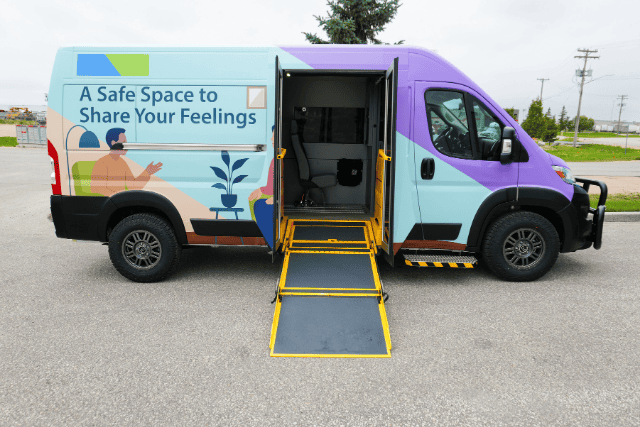
At AVAN Mobility, we’ve spent more than a decade helping healthcare teams, counties, and nonprofits reach people who can’t always come to care on their own. Every mobile behavioral health unit we build starts with listening to your story and understanding your community. Our mission is to help you bring dignity, access, and life-changing care directly to the people who need it most. If you have questions, click the button below to talk to a mobility expert who truly understands your mission.
If you’re not ready to talk to a mobility expert yet, these resources will help you take the next step:
- What’s a Mobile Counseling Unit? Take a look at how a Mobile Counseling Unit can help you deliver behavioral healthcare directly to those in need.
- How can your organization make use of opioid settlement funds? Learn how your organization can make use of opioid settlement funds to help those in need.
- Mobile crisis units vs. stationary crisis units: Read a detailed comparison of which of these units can potentially have a bigger impact.
